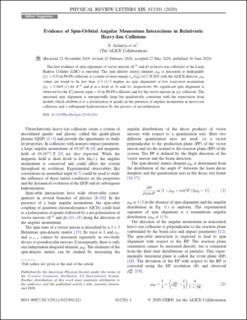Evidence of spin-orbital angular momentum interactions in relativistic heavy-ion collisions
Acharya, Shreyasi; Adamová, Dagmar; Adler, Alexander; Adolfsson, Jonatan; Aggarwal, Madan M.; Aglieri Rinella, Gianluca; Agnello, Michelangelo; Agrawal, Nikita; Ahammed, Zubayer; Ahmad, Shafiq F.; Alme, Johan; Altenkaemper, Lucas; Djuvsland, Øystein; Eikeland, Viljar Nilsen; Ersdal, Magnus Rentsch; Fionda, Fiorella Maria Celeste; Grøttvik, Ola Slettevoll; Lofnes, Ingrid Mckibben; Nystrand, Joakim; Rehman, Attiq Ur; Røhrich, Dieter; Tambave, Ganesh Jagannath; Ullaland, Kjetil; Wagner, Boris; Yang, Shiming; Yuan, Shiming; Zhou, Zhuo; Arsene, Ionut Cristian; Dordic, Olja; Lardeux, Antoine Xavier; Mahmood, Sohail Musa; Malik, Qasim Waheed; Neagu, Alexandra; Richter, Matthias; Røed, Ketil; Skaali, Toralf Bernhard; Tveter, Trine Spedstad; Wikne, Jon Christopher; Helstrup, Håvard; Hetland, Kristin Fanebust; Kileng, Bjarte; Nesbø, Simon Voigt; Storetvedt, Maksim Melnik; Langøy, Rune; Lien, Jørgen André; Ahn, Sang Un; Akindinov, Alexander; Al-Turany, Mohammed; Alam, Sk Noor; De Albuquerque, Danilo Silva; ALICE, Collaboration
Journal article, Peer reviewed
Published version

Åpne
Permanent lenke
https://hdl.handle.net/11250/2756088Utgivelsesdato
2020Metadata
Vis full innførselSamlinger
Sammendrag
The first evidence of spin alignment of vector mesons (K*0 and ϕ) in heavy-ion collisions at the Large Hadron Collider (LHC) is reported. The spin density matrix element ρ00 is measured at midrapidity (|y|<0.5) in Pb-Pb collisions at a center-of-mass energy (√sNN) of 2.76 TeV with the ALICE detector. ρ00 values are found to be less than 1/3 (1/3 implies no spin alignment) at low transverse momentum (pT<2 GeV/c) for K*0 and ϕ at a level of 3σ and 2σ, respectively. No significant spin alignment is observed for the K0S meson (spin=0) in Pb-Pb collisions and for the vector mesons in pp collisions. The measured spin alignment is unexpectedly large but qualitatively consistent with the expectation from models which attribute it to a polarization of quarks in the presence of angular momentum in heavy-ion collisions and a subsequent hadronization by the process of recombination.
